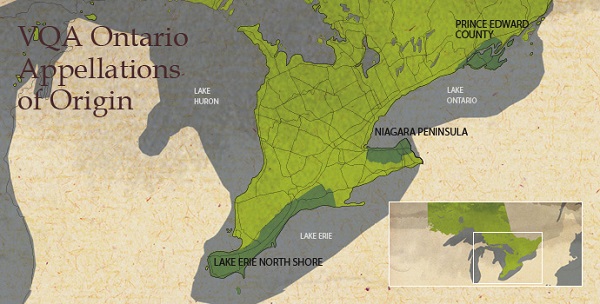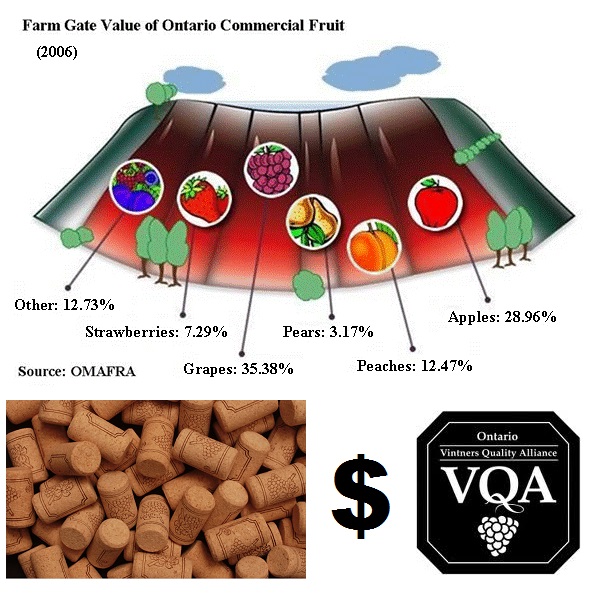
Maxim Voronov is Associate Professor of Strategic Management at the Goodman School of Business, Brock University, and is also a Fellow of the Cold Climate Oenology and Viticulture Institute (CCOVI), one of the principle academic research engines currently informing the Ontario wine industry; helping it find its rightful and deserved place in the global marketplace.
Oenology (pr. Een-ology) comes from the Greek root oinos, and essentially means “the study or science of winemaking.” Professor Voronov, along with fellow Brock colleagues Dirk De Clercq and Narongsak Thongpapanl, and with Bob Hinings of the University of Alberta School of Business, recently completed a 6 year study of the Ontario wine industry and its strategic positioning in relation to its international, and often more established competitors.
In an exclusive interview with The Silo via Skype, Professor Voronov outlined the overall methodology of his study. He and his colleagues conducted interviews with various stakeholders in the Ontario wine industry, including makers and growers, LCBO executives, wine critics, and they surveyed press coverage, websites, and over 250 restaurateurs regarding their attitudes toward Ontario wine. Their conclusions: the Ontario wine industry needs to adopt a two-fold focus in order to hold their own in a competitive global market. There are 3 distinct growing regions or “appellations” in Ontario (otherwise known as DVA’s or Designated Viticultural Areas). They are the Niagara Peninsula, our largest and arguably most “storied” region, Prince Edward County to the east, and the Lake Erie North Shore appellation to the south-west, beneficiary of the greatest number of heat-units per growing season, including Pelee Island and, hopefully soon, our own, relatively new “South Coast” growing region. But in spite of these localized differentiations, cautions Voronov, ultimately our industry represents a cool-climate production zone by international standards and needs to focus on grape varietals that can consistently and reliably perform in a somewhat unreliable climate.

The second area of focus needs to be the conscious practice of exporting the best of Ontario fine wines to the “tastemaking” markets of the wine world, like New York and London. Commercial and critical success in these regions will not only cement Ontario’s legitimate place in the global wine industry, but also enhance the attractiveness of Ontario fine wines in our own, domestic market, somewhat akin to the phenomenon of the Canadian actor or musician who labours away in relative obscurity for years, until finally being “discovered” by some international authority and emerging as a hometown hero. A recent effort on this front was the “Rediscover Canadian Wines” trade and media tasting event at the Canadian Embassy in Trafalgar Square, London, England. Supported by Wine Country Ontario, in partnership with Foreign Affair and International Trade Canada, The Ontario Ministry of Agriculture and Food, and the Canadian High Commission in London, this was a major wine happening. Our own CCOVI hosted and organized the wine submissions for the screening process.
About 100 Canadian wines were chosen for the high profile tasting. On May 16th, the day of the event, world renowned wine expert Jancis Robinson, author of The Oxford Companion to Wine, now in its third edition, tweeted: “Today’s Canadian tasting in London shd have dispelled a few prejudices” (@JancisRobinson). Still, Ontario remains one of the most open marketplaces in the world, which means that domestic wines must compete with a vast array of both new and established global brands without necessarily enjoying a home advantage. Ontario does not currently export significantly to other markets, and local wineries are caught in a kind of dilemma: that of establishing conformity with old-world traditions in a “New Age” of Ontario fine-winemaking, while at the same time trying to assert their distinctiveness in the context of international trade.
A word here on price-point. Many Ontario consumers who would otherwise like to support the local industry wonder why they should pay more for an Ontario wine than a proven, reliable import. A good question. According to Voronov there is a simple answer: economies of scale. The greater number of product units generated, the lower the overall cost per unit to the consumer. Comparatively, most Ontario wineries are small and have to contend with fickle climates. Ontario simply cannot compete on a unit cost basis with international wineries boasting thousands of acres of land in relatively stable climates. And in a global industry currently fascinated with big, bold red wines—which flourish primarily in warm growing regions—Voronov believes Ontario needs to unapologetically embrace its cool-climate status and focus on light to medium-bodied reds which can be consistently and confidently produced, wines like Pinot Noir, Cabernet Franc and the Baco-Noir hybrid so successfully expressed by Niagara’s Henry of Pelham.
A notable exception came up in the April 27th edition of Vintages Magazine, where Norfolk County’s own Burning Kiln Winery’s “Strip Room Merlot/Cabernet Franc” was identified and praised as an “Ontario appassimento.” Burning Kiln is one of a number of Norfolk County Wineries to receive the VQA (Vintner’s Quality Assurance) stamp of approval. The VQA designation, similar to the AOC and DOC systems in France and Italy respectively, provides assurance that the consumer is purchasing quality “wines of origin” that have met strict guidelines for excellence (www.vqaontario.com). Now back to appassimento. The method is an ancient one and involves drying harvested grapes to the point of shriveling, in order to concentrate the fruit sugars and therefore the overall boldness and complexity of the wine. Italian Amarone is well known appassimento, but it exists in very elite class, with retail prices starting in the $40-$60 range and up.

Coming in at $24.95 a bottle, Burning Kiln’s Strip Room appassimento is a bargain and may well be worth trying as a new, local expression of an ancient technique. There is debate over whether, in the long term, appassimento can be seen as an answer to Ontario’s problem producing bolder reds. According to Professor Voronov, we need to concentrate on what we do best, including aromatic whites like Riesling and Chardonnay, grapes whose character actually benefit from ample day to night temperature fluctuations and generally cooler conditions. An interesting side note: Australia, with its warm climate, has had little success in producing a Riesling of note. According to celebrated wine critic Ian D’agata, Director of the International Wine Academy in Rome: “Once wine lovers the world over realize that Ontario and parts of BC are some of the few viticultural areas in the world with the potential for truly memorable pinot noir, and that Canada is already one of the three or four best countries in the world for riesling, with more than adequate chardonnay, pinot gris and more, Canadian wines will become increasingly sought after.” As an example, Cave Springs Estates Riesling, of the Beamsville Bench Niagara sub-appellation, has gained a reputation as one of the world’s finest dry Rieslings. In the opinion of Voronov et. al, the Ontario industry as a whole needs to have a conversation about its identity, its image—its “symbolic value in the aggregate.”
Symbolic value refers to a sense of “specialness” above and beyond what is simply contained in the bottle. There are several recognized ways to create symbolic value for any experience-based product, one of which is called “rhetorical history.” Interestingly, big multinationals like Kellogg’s and IBM have begun to employ “corporate historians,” people with a knack for selectively engaging the “facts” in order to create value-laden narratives for the benefit of their brands. In other words, Ontario wineries need to tell compelling stories about their products: the generations of family who have worked the land, the continued utilization and restoration of historic buildings, connections to old-world practices and techniques, and meaningful innovations based on their particular terroir (which I will come back to shortly). Again, Burning Kiln asserts itself as a savvy business in this respect. It turns out that tobacco kilns maximize air flow and provide a perfect drying environment for the appassimento style. In this way, the winery can embrace its history of tobacco production on the land while at the same time profiting from historic structures (the kilns, not to mention the attractive main building, which is a repurposed pack barn) to create a novel, local innovation tied to a centuries-old Greek and Italian wine tradition.
This brings us back around to the concept of terrior [April 2011 https://www.thesilo.ca/terroir-what-this-means-to-local-wine-and-cheese-by-scott-jensen/ CP] —I promised I’d return. Literally the word means “land,” but in the wine industry, terroir is an essential part of the story of any wine or wine region. It refers to the set of special characteristics that the geography, geology, soil conditions and climate of a particular place, interacting with plant genetics, add to agricultural products such as wine, coffee, chocolate, etc. You can visit the website of virtually any global winery and find a detailed discussion of its particular, and therefore inherently “special,” terroir. But put aside for a moment the individual soil characteristics of the various Ontario wine regions, dating back to glacial histories—which do indeed influence the personalities of individual wines—and consider the overarching and, according to Voronov and associates, critical variable of cold and often fluctuating climate conditions.
And then consider a very interesting case study and global success story: New Zealand. New Zealand, as a cool-climate wine region, is producing some respectable reds like Pinot Noir and Syrah, a mellower version of the now famous Australian Shiraz (same varietal, different spelling). But the vintners of New Zealand, overall, seem to have consciously and intentionally hitched their wagons to the production of aromatic whites like Chardonnay, Pinot Gris and, most especially, Sauvignon Blanc. Now, I am no certified sommelier, but I can say that my experience of Kim Crawford’s Marlborough Sauvignon Blanc, one of the region’s leading and critically acclaimed exponents of the varietal, stands as an utterly distinct expression of the grape compared to European examples. Its full-mouth, fruity and floral character completely sets it apart from traditional European Sauvignon Blancs. It is absolutely worth the extra few dollars. It is unique, distinct: “special.” New Zealand has embraced its uniqueness, and, this point is instructive—so has the rest of the world. Because New Zealand, unlike Ontario, exports its wines prodigiously. The Ontario Wine industry could take a few pointers here.
Symbolic value, in the end, won’t mean much if the wine in the bottle doesn’t live up to its constructed narrative, no matter how enticing. Ontario’s climate, on the whole, lends itself to the production of some respectable light to medium- bodied reds, but, like New Zealand, our terroir, on the whole, is most amenable to producing exceptional aromatic whites. The Prince Edward County appellation, not to mention being uncommonly picturesque, is Ontario’s coldest wine region, with a shorter growing season and colder winters than Niagara, yet it still produces wines of both national and international distinction. According to Montreal Gazette wine critic Bill Zacharkiw, much like New Zealand, “PEC’s greatest strength, aside from its limestone soils, is that it seems to have accepted who it is and is comfortable with that.” In his six year study, Voronov found what he considers an over-emphasis on the part of Ontario wineries with conformity to “old-world” traditions, and not enough emphasis on our distinctiveness, our specialness—on what we and only we can do given the particularities of our unique terroir. For Voronov, the Ontario industry needs to consider the construction of a “meta-image” for Ontario wine, an overarching “meaning structure,” including, perhaps, environmental sustainability, that will resonate with both domestic and international consumers, backed up by the consistently reproducible quality of the product.
Think about it: wouldn’t it be great to see a day when more Ontario consumers pick up a bottle of locally produced wine and say, “Ya, this is worth the extra few bucks.” For the Silo, Alan Gibson.
Supplemental– Grape Growers of Ontario http://www.grapegrowersofontario.com/ontarios-grape-and-wine-industry
Cool climate oenology and viticulture institute at Brock University http://www.brocku.ca/ccovi/
